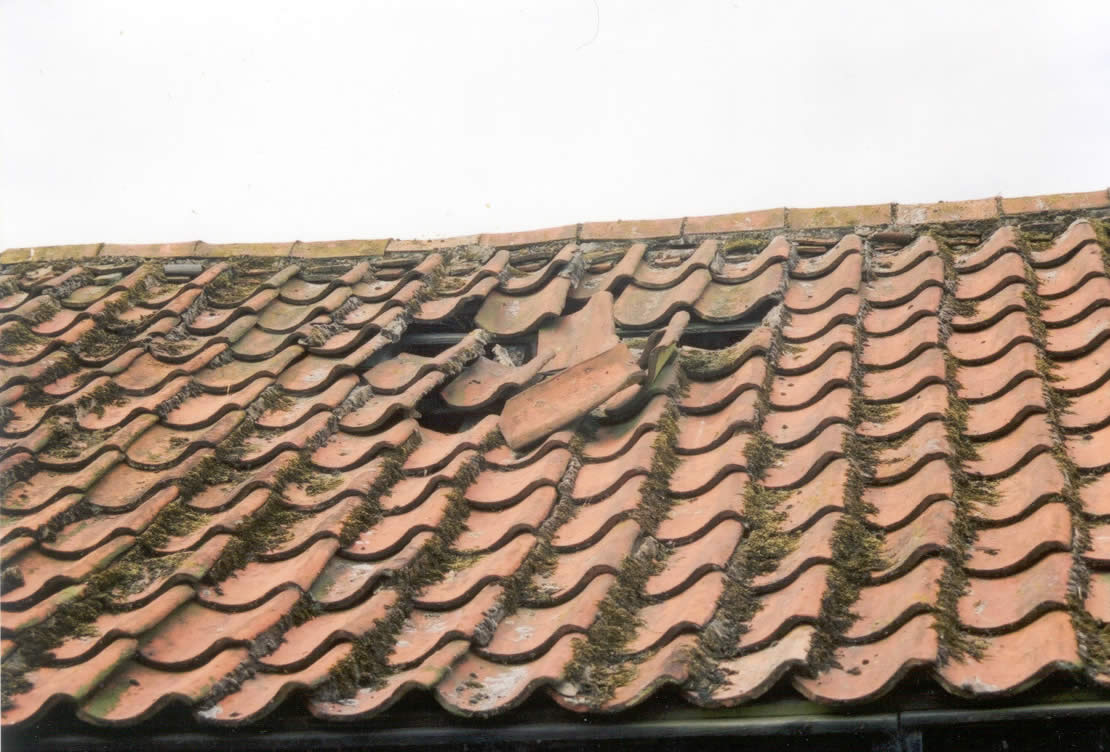

An accurate diagnosis of the type and cause of a dampness problem is essential if it is to be treated effectively. It is alarming, however, how often this stage is skipped or a problem misdiagnosed. This can lead to unnecessary and expensive ‘remedial’ work that damages the building fabric, notably through some irrelevant solution for a non-existent rising dampness problem (see section 4.3).
Sometimes the diagnosis may be self-evident, (see figure 17); frequently, however, it is less obvious and needs investigating. Applying staged remedies can help to accurately diagnose the cause of dampness. Before embarking on extensive work, therefore, the first step may entail nothing more than basic maintenance, such as clearing a blocked gulley, to see if it addresses the problem or further action is needed.

It might be necessary to employ an appropriate independent specialist to diagnose a dampness problem. It is strongly advisable to seek advice required with diagnosing a major dampness problem separately from quotations for work to address it. Taking such advice first (for example, from a chartered building surveyor or other appropriately qualified individual) will prevent vested commercial interests giving rise to recommendations for more work than is strictly necessary (which can occur when a remedial treatment contractor is asked to both diagnose and resolve dampness). Free surveys are also best avoided.
In the SPAB’s experience, mortgage lenders can demand unnecessary damp-proofing work during house purchases. Although mortgage valuers have a duty to follow a trail of suspicion, some simply pass all responsibility onto remedial treatment contractors with a vested commercial interest encouraging over-specification. It is worth challenging any diagnosis you believe is questionable and, if necessary, seeking a second opinion in writing from an independent chartered building surveyor or consultant (note, not contractor). The SPAB may be able to advise you on suitable names.
A methodical step-by-step approach is advocated, as described in sections 4.2 to 4.5.9
The human senses must not be undervalued because the sight, feel and smell of dampness can often provide adequate information. Be very wary of tasting deposits to determine the presence of salts, however, because hazardous chemicals, such as pentachlorophenols, were used in the past to treat areas of decay. The starting point is to check for the symptoms discussed earlier in section 2, taking into consideration the date the property was built, whether it is unoccupied or unheated, the occupancy type, exposure and recent weather, dampness duration, location, colour and shape of patches, stains, mould and salts.
A careful inspection of the roof, parapets, parapet and valley gutters, and abutments should be made, especially exposed horizontal surfaces and areas likely to collect water. Water from leaks can run down rafters or, more occasionally, the underside of the roof to appear inside the building some distance away.
It is often instructive to observe the performance of the rainwater disposal system below the roof during heavy rainfall. The rainwater head, gutters and downpipes that appeared to deal adequately with average rainfall can fail under heavy and prolonged periods of rain. There have been occasions when dampness has been due to the failure of downpipes which had been embedded at an earlier date within walls. The inspection of gulleys during rain can also reveal blockages.
The height of ground levels and condition of external wall faces should be examined carefully. Pay particular attention to the pointing, which can be very vulnerable to water penetration. Traditional lime mortars tend to absorb moisture and release it later. Modern cementitious mortars often permit water penetration through hairline cracks on the perimeter of, and within, the pointing material.
Joints in protruding elements such as parapets are particularly vulnerable, especially if not covered (for example, with lead sheet or slate).
Diagnosis sometimes requires more scientific approaches than the sight, feel and smell of dampness. Dampness can be hazardous long before it is detectable by human senses and electrical moisture meters help to establish the presence and amount of moisture scientifically. (See figure 18.) Using electrical moisture meters to plot the distribution of moisture can give very helpful clues about its source (Table 1). Electrical moisture meters are also particularly useful for detecting changes in the moisture content of materials.

Rising dampness is widely misdiagnosed on the basis of high electrical moisture meter readings alone. Elevated readings occur frequently in old buildings that are not unduly damp, due to salt deposition from evaporation associated with a previous dampness problem, or the presence of certain timber preservatives, foil-backed wallpaper or carbon-containing materials (for example, in breeze blocks or black wallpaper coatings); or they can indicate another problem altogether, such as penetration from rainsplash or condensation.
If rising dampness exists, there will be visible indications too, such as an accompanying tide mark.
Various accessories are available for use with EMMs, for example, hammer electrodes that can be helpful when measuring the moisture content in joists without lifting floorboards.
Dampness source | Distribution of meter readings |
||
|
Usually tail off sharply Tail off sharply with height Normally localised |
||
|
Tail off gently Usually tail off fairly sharply above and below the area of salt deposition unless there is a continuing source of moisture |
Dampness source |
Salts present |
|
| For liquid moisture | Rainwater penetration | No salts typically (possibly sodium chloride near coasts) |
| Below-ground dampness | Nitrates and generally chlorides - important clue | |
| Plumbing leaks | Chlorides and possibly nitrates | |
| Other | Chlorides from urine or sea water | |
| For moisture from the air | Condensation | No salts |
| Hygroscopic salts | Chlorides, nitrates or ammonium sulfate | |
An in-depth investigation is likely to be required to help build up a better picture of a dampness problem if steps 1 and 2 have not enabled a diagnosis.
Salt tests can provide valuable information and be undertaken on site using an analysis kit or use made of a laboratory service. Typical results of salts testing are given in Table 2.
Relative humidity and dewpoint can be ascertained with instruments such as the whirling hygrometer. The use of other equipment can also be helpful, including infrared cameras for mapping moisture. These detect temperature differences.
Wet areas will usually have a different temperature to dry ones, due to, for example, evaporative cooling. Wooden or metal ‘listening sticks’ or stethoscopes can be used in other situations to detect plumbing leaks.
In some cases, it will be necessary to carry out more advanced forms of testing to diagnose the cause of a dampness problem. Such tests include the use of carbide meters or the gravimetric (oven-drying) method. They are time-consuming and intrusive but can help avoid unnecessary and harmful work by, for example, determining whether a wall is significantly damp within its thickness.
Some monitoring of the internal environment within a building may also be beneficial. Modern data loggers, which are more versatile and less expensive than their earlier counterparts, have the advantage of providing a longer-term picture of conditions than a one-off assessment, so can assist, for instance, in determining seasonal effects or building performance in relation to lifestyle.